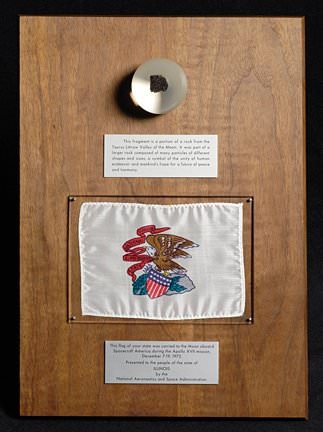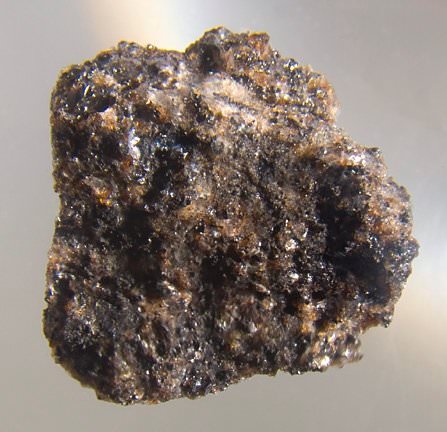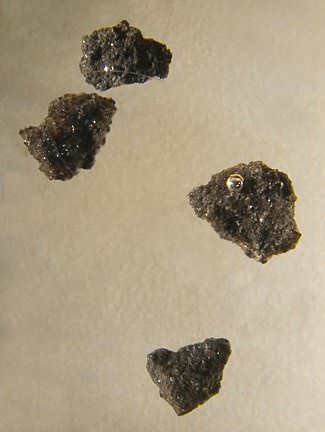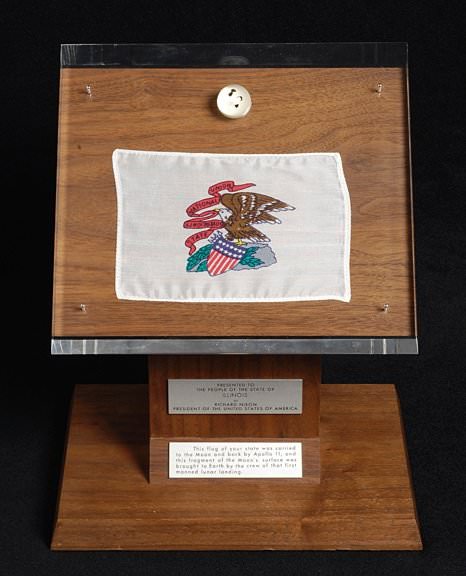[/caption]
Wanted: Moon rocks. Whereabouts: Unknown.
Alarmingly, some of our Moon rocks are missing! After the Apollo Moon landings, then-U.S. President Richard Nixon distributed approximately 250 displays containing lunar surface materials from Apollo 11 (1969) to the 50 states and various other countries around the world, and then later gave away 135 rock samples from Apollo 17 (1972). But NASA is finding that a surprisingly low percentage of these precious rock samples — which are encased in acrylic and mounted on a plaque along with the intended recipient’s flag — can actually be located.
Robert Pearlman at CollectSPACE.com has put together two lists, and the whereabouts of only 42 of the Apollo 11 rock samples are known, while only 61 of the Apollo 17 rocks have been located.
Earlier this week, an article in the Honolulu Advertiser rejoiced that Hawaii’s missing Moon rocks had been found in a locked cabinet. The rocks weren’t technically lost, an advisor to Hawaii’s governor said, they just didn’t know exactly where they were.
That seems to be the case with many other Moon rock samples. When the rocks were given away 40 years ago, they became the property of the countries or states who received them. As time passed, administrations or regimes changed, and the rocks were likely either lost, stolen or locked away who knows where.
Joseph Gutheinz, a professor with the University of Phoenix who teaches investigative techniques now has 28 students hunting down the missing moon rocks around the nation and the world.

I was happy to see the two Moon rock samples given to the state of Illinois – where I currently live—are safe and sound. And in response to the search by one of Gutheinz’s students, Lisa Moore, the Illinois State Museum decided to put the Moon rocks back on display, after a ten-year hiatus.
“The Moon rocks given to the State of Illinois haven’t been on display for about 10 years, at least in our permanent display,” said Chris Widga, Assistant Curator of Geology at the Illinois State Museum. “But when they are not on display they are at the Research and Collections Center that we have here in Springfield, or they do make it out one to three times a year to various rock, gem and mineral shows. So they usually get seen by quite a few people.”
But now they’ll be viewed by many more eyes, as they are in the lobby of the museum.

The sample from Apollo 11 is a Lucite ball with a four small rocks (more like pebble-sized) and the rock from Apollo 17 is one larger, about the size of a dime.
I asked Widga if beyond possibly picking up some SWAG at rock and mineral conventions, if the Illinois Moon rocks have had any other excitement such as going to an interesting location or being viewed by a celebrity.
“You know, I don’t think so,” he said. “They lead a fairly dull and boring life, which is probably good given some of their cousins have been lost. If we ever have a difficult time locating objects in our collection they usually are ones described as being from 1855 or something like that, further back in time and more difficult to track down.”
But I also found out there are two other Moon rock samples in Illinois that I wasn’t aware of. However, they are likely not Apollo Moon rocks, but perhaps meteorites, that may be from the Moon.
The Funk Prairie Home & Rock Museum in Shirley, Illinois has what they say are two Moon rock samples. They are part of the collection of Lafayette Funk, a member of the family who founded the Funk Seed Company.
“As far as we can tell, Mr. Funk got them from President Nixon,” said Bill Case, curator of the Funk Museum. “He was presented with them at a conference, and on the case it says, ‘Tektite from the Moon, established from the Third International Tektite Symposium, co-sponsored by the Smithsonian Institute and the Corning Museum of Glass’.”
Case said the rocks are in glass cases, and are pock-marked black tektite; one is tear-dropped shaped and about 3.5 inches long by 1.25 inches wide, and a half an inch thick. The other is more rounded, about 2 inches across, and one edge is chipped off to show the shiny, glassy black interior.
“Mr. Funk built a mineral museum, and he collected minerals from all over the world,” Case said. “He had wide-ranging contacts from all over the world and the Funks were advisers to various presidents, so it is not surprising that he would receive something from the President of the United States. In fact we have cases of things from various heads of states.”
Case said recently, a friend of Lafayette Funk who was on board the aircraft carrier with President Nixon when Apollo 11 splashed down gave the museum a photograph and confirmed that the time period when Lafayette got the Moon rocks was during the Apollo missions.

According to Robert Pearlman of CollectSPACE, however, no individual was ever presented with an Apollo-recovered moon rock, not even a president, astronaut, religious figure or state leader. “The only moon rocks returned by astronauts ever given away were those presented as goodwill gifts to the citizens of the nations/states as listed within the two guides on collectSPACE,” Pearlman told Universe Today. “Tektites are not confirmed to be of lunar origin. They were believed to be from the Moon but other research suggests they are terrestrial material that was ejected back into space (by impact or volcanic eruption) and then reentered through the atmosphere.”
So, these rocks may or may not be from the Moon. If any readers have any insight on these rocks, we’d love to hear about it.
Unfortunately, some of the diplomatic gifts of Apollo lunar samples have found their way onto the black market. There’s no real way to know exactly how valuable the Moon rocks are, said Pearlman, because there are so few samples to judge the market. But Gutheinz believes they could be worth up to $10 million each.
Each Apollo mission brought back between 60 and 110 kg of lunar materials and the majority of Moon rocks are housed in the Lunar Receiving Laboratory at Johnson Space Center.
NASA’s education program loans out lunar samples to specially certified educator to use, and the restrictions for storing and using the educational samples are quite strict. It is regrettable that the diplomatic lunar samples didn’t have equal care and and restrictions.
For more info:
Illinois State Museum
Illinois State Museum’s Facebook page
Funk Prairie Home and Rock Museum
Additional Sources: CollectSPACE, Wired

